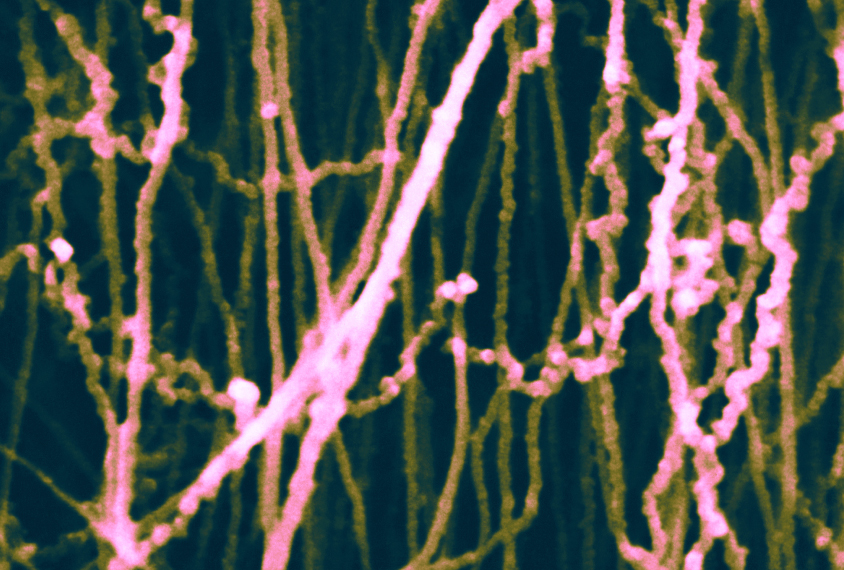
THIS ARTICLE IS MORE THAN FIVE YEARS OLD
This article is more than five years old. Autism research — and science in general — is constantly evolving, so older articles may contain information or theories that have been reevaluated since their original publication date.
A new chart of DNA’s loops and twists reveals its three-dimensional (3-D) structure in the developing brain. It shows that a genomic region involved in controlling gene expression may influence a gene located far away on a linear genome, as long as the two regions abut in 3-D space1.
The findings have big implications for interpreting the role of genetic variants located between genes. For decades, researchers worked under the assumption that variants in noncoding regions control a gene closest to them, says lead investigator Daniel Geschwind, professor of neurology, psychiatry and human genetics at the University of California, Los Angeles. The new study shows instead that these variants are “equally likely to be regulating something 100 kilobases away as they are the closest gene,” Geschwind says.
DNA folds around proteins to form a complex structure called chromatin. Scientists have mapped these loops in stem cells and lung tissue. The new study is the first to map chromatin structure in human brain tissue, the most relevant tissue for studying conditions such as autism and schizophrenia. It appeared 19 October in Nature.
“This study is very important for understanding the effect of genetic variation linked to psychiatric diseases in noncoding regions,” says Kasper Lage, group leader at the Stanley Center for Psychiatric Research at the Broad Institute in Cambridge, Massachusetts, who was not involved in the study.
Tracking twists:
Geschwind and his colleagues mapped chromatin loops in two regions of the brain’s outer portion, the cerebral cortex. The ‘germinal zone’ is home to developing neurons and the ‘cortical plate’ to mature neurons.
The researchers extracted DNA from three embryonic brains. Using a method called Hi-C, they fused regions of DNA that are close. They then chopped up the DNA and sequenced across the fused segments. In this way, they were able to map when two regions are closer together than expected based on DNA’s linear sequence.
“What sets this [study] apart is the source of the biological material,” says Michael Ronemus, research assistant professor at Cold Spring Harbor Laboratory in New York. The researchers “have done these experiments about as well from a design and technical standpoint as anyone could,” he says.
The map confirmed that variants known to control gene expression tend to lie close to their target genes in the 3-D structure. What’s more, regions of chromatin that turn on expression are near active genes, and those that repress expression are close to silenced genes.
“The manuscript seems very convincing that what they detect is real and could be very useful,” says Ivan Iossifov, assistant professor at Cold Spring Harbor Laboratory in New York, who was not involved in the study. Interpreting variants in noncoding regions is difficult when analyzing whole genomes, Iossifov says. “This is one hope that potentially this [map] could help.”
Brain effects:
Geschwind’s team then focused on a set of more than 2,000 regions known to control genes in the developing brain. About 65 percent of these so-called ‘enhancers’ interact primarily with distant genes. Previous studies that looked only at the regions’ linear coordinates missed these interactions2.
The team also compared the locations of enhancers in the brain with their positions in chromatin maps from stem cells or fetal lung cells. Of the 2,672 genes the study identified as targets for enhancers, 40 percent are near the enhancers only in neurons. The finding underscores the importance of looking at tissue-specific chromatin maps.
The brain-specific target genes function in processes such as neuronal signaling and directing neuronal growth during development. They also carry an excess of mutations linked to intellectual disability.
The researchers also looked at a set of 108 variants linked to schizophrenia, most of which do not land in genes. The 3-D map places these variants close to roughly 500 genes that are far away in linear space. Nearly one-third of the genes are adjacent to the schizophrenia variants in embryonic brain tissue but not in stem cells or lung tissue.
Of the 500 genes, 6 are involved in detecting the chemical messenger acetylcholine. The results lend credence to efforts to develop schizophrenia treatments that activate the acetylcholine receptor.
Researchers can similarly use the map to investigate the role of autism-linked variants that fall outside of genes.
By joining the discussion, you agree to our privacy policy.